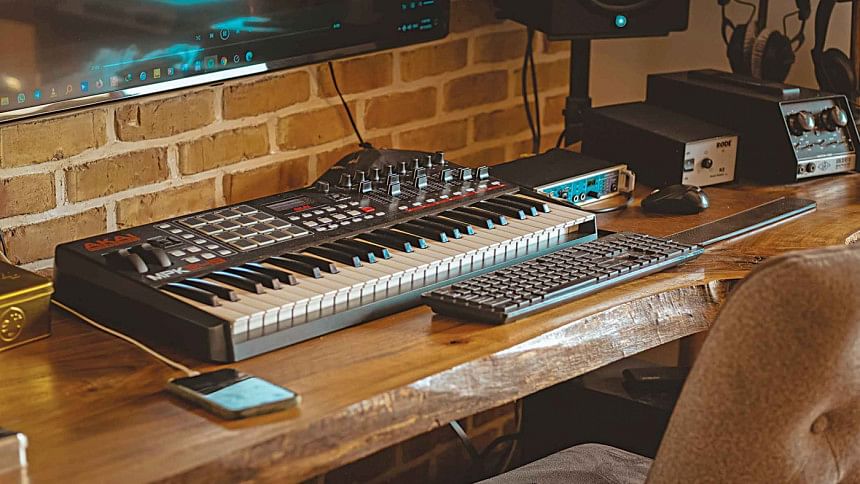A beginner’s guide to setting up a home studio

If you're a producer, a vocalist, a musician or have a podcast and you've decided to start recording professionally, the next step can be the most confusing one. Setting up a studio. And if you're just starting, there's no need to break the bank. You can set up a highly efficient studio at a comfortable price right in your home. Let's take a look at all the gear you'll need to start recording immediately.
Computer
A computer will be at the heart of your recording setup. And good news! If you already have one at home, it's likely to be more than good enough. In the beginning, it's not necessary to buy a specialized PC or MacBook solely for recording. Modern computers are powerful machines and should have enough juice to facilitate your recording. If it has a core i5 processor and 8GB of RAM, you're good to go.
Digital Audio Station
Once you have a computer, you'll need software that you can record into. This software is known as a DAW. A DAW does all kinds of digital manipulation of your audio, starting from recording your material to adding effects, tones, drum tracks and all other kinds of digital instruments. It's the digital platform where you can record, mix and master your track. There are plenty of DAWs available and each has its strengths and specialities and drawbacks. It's a subjective choice and whichever DAW agrees with you more is the right one. Some of the most widely used DAWs include Ableton Live, FL Studio, Logic Pro, Reaper 6 etc. If you don't have any budget for a DAW there is even free software such as Audacity to help you get started.
Audio Interface
The next piece of gear you'll need is an audio interface. An audio interface is a device that captures your sounds and transports them to the DAW in your computer. It's usually connected to the computer via a USB cable. You can plug your instruments such as a guitar or a bass directly into the audio interface and record into the DAW. Or if you prefer using a mic for recording, you can connect the mic to the audio interface. An audio interface commonly has a preamp built-in that takes the sound of the mic and boosts it up to a level that's suitable for working within the computer. Without a preamp, the mic will usually be a little too quiet. Most audio interfaces come packed with DAWs so you'll be taking care of two pieces of equipment by buying an audio interface. One of the most popular audio interfaces is the Focusrite Scarlett Solo. Other common ones include the PreSonus Audio Box, M-Audio Mtrack etc.
Microphone
If you're ever going to record any vocals, you'll be needing a microphone. But even if you're not a vocalist, a mic is still quite an essential piece of equipment. It can record the acoustic guitar, electric guitar and bass played through an amp and any other instrument with great clarity and detail. Even though instruments can be plugged into the audio interface and recorded directly into the computer, a microphone captures the accents and subtle nuances much more efficiently. Mics are usually categorized into three types: dynamic, condenser and ribbon mics. Each has its benefits and downsides. To get started, the best option is a large-diaphragm condenser mic. It can handle sounds ranging from loud to quiet and everything in between. Samson c01 is a quality budget condenser microphone that can handle all kinds of recording for a beginner.
MIDI Keyboard
A MIDI keyboard is a very efficient piece of gear because of its versatility and scope. A MIDI will allow you to record piano parts, percussion, drums, strings, choir, synthesisers- essentially any kind of sound a producer might fancy. Even if you have a very basic knowledge of playing the piano, you can use a MIDI controller for creating ambience, wonderful sonic textures and soundscapes. It usually connects to the computer via USB and records directly into the DAW. There's an inexhaustible range of MIDI controllers in the market, each with specific features and tools. A solid MIDI keyboard for its price range is the Akai MPK Mini Mk2. Other MIDIs to consider are Arturia MiniLab MkII, Novation Launchkey Mini Mk3 etc.
Headphones/Studio Monitors
The next piece of equipment will let you hear what you're recording, mixing and mastering. While it can prove difficult for professionals to use headphones for long periods, it's still budget-efficient and sensible to start with high-performance headphones rather than spending a lot of money on studio monitors. They are many classifications to consider when buying a studio headphone: on-ear, over-ear, open-back, closed-back. But the merits and disadvantages of these different kinds of headphones only become apparent if someone's an advanced producer. To start, any decent quality headphones should get the job done. A classic pair of headphones at a reasonable price for studio use is the Audio-Technica MX20. Other headphones include Audio-Technica ATH M50x, Sennheiser HD280 Pro etc.
Now you have a fully functional, professional recording setup. There are some other products you can invest in for a more comfortable experience and higher productivity. This includes mic stands, pop filters, high-quality cables, acoustic treatment etc. As you start to make good use of your studio, you should start looking into these gears and more for adding some wonderful extra touches. A properly set-up home studio goes a long way in inspiring creativity and professionalism in you. There's no reason to get perplexed at the production process. You can start with a very reasonable budget and begin recording at your home today!

 For all latest news, follow The Daily Star's Google News channel.
For all latest news, follow The Daily Star's Google News channel. 



Comments